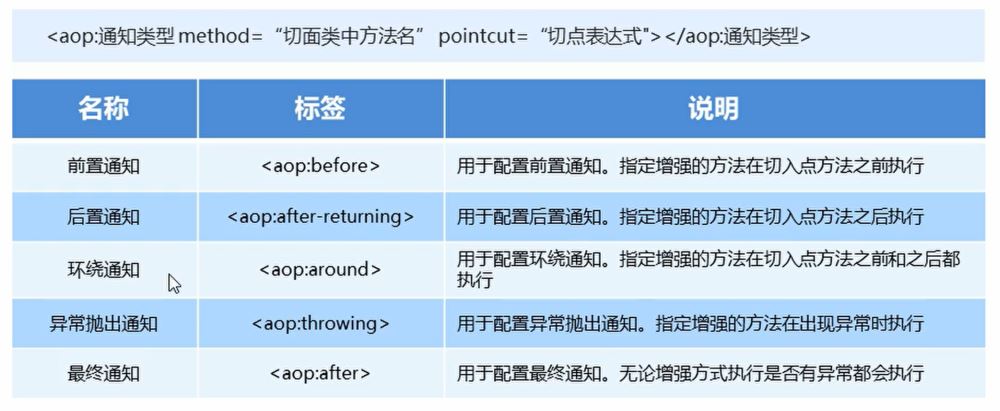您好,登錄后才能下訂單哦!
您好,登錄后才能下訂單哦!
這篇文章主要介紹了Spring中AOP的切點、通知和切點表達式源碼分析的相關知識,內容詳細易懂,操作簡單快捷,具有一定借鑒價值,相信大家閱讀完這篇Spring中AOP的切點、通知和切點表達式源碼分析文章都會有所收獲,下面我們一起來看看吧。
編寫核心業務代碼(目標類的目標方法)
編寫切面類,切面類中有通知(增強功能方法)
在配置文件中,配置織入關系,即將哪些通知與哪些連接點進行結合
Spring 框架監控切入點方法的執行。一旦監控到切入點方法被運行,使用代理機制,動態創建目標對象的代理對象,根據通知類別,在代理對象的對應位置,將通知對應的功能織入,完成完整的代碼邏輯運行。
在 spring 中,框架會根據目標類是否實現了接口來決定采用哪種動態代理的方式。
aop:面向切面編程
aop底層實現:基于JDK的動態代理 和 基于Cglib的動態代理
aop的重點概念:
Pointcut(切入點):被增強的方法 Advice(通知/ 增強):封裝增強業務邏輯的方法 Aspect(切面):切點+通知 Weaving(織入):將切點與通知結合的過程
開發明確事項:
誰是切點(切點表達式配置)
誰是通知(切面類中的增強方法)
將切點和通知進行織入配置
1.2.5.1 快速入門
①導入 AOP 相關坐標
②創建目標接口和目標類(內部有切點)
③創建切面類(內部有增強方法)
④將目標類和切面類的對象創建權交給 spring
⑤在 applicationContext.xml 中配置織入關系
⑥測試代碼
①導入 AOP 相關坐標
<!--導入spring的context坐標,context依賴aop--> <dependency> <groupId>org.springframework</groupId> <artifactId>spring-context</artifactId> <version>5.0.5.RELEASE</version> </dependency> <!-- aspectj的織入 --> <dependency> <groupId>org.aspectj</groupId> <artifactId>aspectjweaver</artifactId> <version>1.8.13</version> </dependency>
②創建目標接口和目標類(內部有切點)
//接口
public interface TargetInterface {
public void method();
}
//實現類
public class Target implements TargetInterface {
@Override
public void method() {
System.out.println("Target running....");
}
}③創建切面類(內部有增強方法)
public class MyAspect {
//前置增強方法
public void before(){
System.out.println("前置代碼增強.....");
}
}④將目標類和切面類的對象創建權交給 spring管理
<!--配置目標類--> <bean id="target" class="com.itheima.aop.Target"></bean> <!--配置切面類--> <bean id="myAspect" class="com.itheima.aop.MyAspect"></bean>
⑤在 applicationContext.xml 中配置織入關系
導入aop命名空間
<beans xmlns="http://www.springframework.org/schema/beans" xmlns:xsi="http://www.w3.org/2001/XMLSchema-instance" xmlns:context="http://www.springframework.org/schema/context" xmlns:aop="http://www.springframework.org/schema/aop" xsi:schemaLocation=" http://www.springframework.org/schema/context http://www.springframework.org/schema/context/spring-context.xsd http://www.springframework.org/schema/aop http://www.springframework.org/schema/aop/spring-aop.xsd http://www.springframework.org/schema/beans http://www.springframework.org/schema/beans/spring-beans.xsd">
⑤在 applicationContext.xml 中配置織入關系
配置切點表達式和前置增強的織入關系
<!--配置織入,告訴spring框架哪些方法(切點)要進行增強(前置增強/后置增強)--> <aop:config> <!--聲明切面--> <!--引用myAspect的Bean為切面對象--> <aop:aspect ref="myAspect"> <!--配置切點--> <!--配置Target的method方法執行時要進行myAspect的before方法前置增強--> <!--切面:切點+通知, 要配置那個方法需要前置增強(要配置切入點,需要增強的方法) --> <aop:before method="before" pointcut="execution(public void com.itheima.aop.Target.method())"></aop:before> </aop:aspect> </aop:config>
⑥測試代碼
@RunWith(SpringJUnit4ClassRunner.class)
@ContextConfiguration("classpath:applicationContext.xml")
public class AopTest {
@Autowired
private TargetInterface target;
@Test
public void test1(){
target.method();
}
}1.2.5.2 切點表達式的寫法
表達式語法:
execution([修飾符] 返回值類型 包名.類名.方法名(參數))
訪問修飾符可以省略
返回值類型、包名、類名、方法名可以使用星號* 代表任意
包名與類名之間一個點 . 代表當前包下的類,兩個點 … 表示當前包及其子包下的類
參數列表可以使用兩個點 … 表示任意個數,任意類型的參數列表
例如:
execution(public void com.itheima.aop.Target.method()) //不常用,具體的方法,限制了 execution(void com.itheima.aop.Target.*(..)) //具體的類下的所有方法都會被增強,無返回值 execution(* com.itheima.aop.*.*(..)) //常用(推薦),該包下的任意類的任意方法(參數任意)都會被增強,返回值任意 execution(* com.itheima.aop..*.*(..)) //aop下及其子包下的任意類任意方法都會被增強 execution(* *..*.*(..)) //全部都任意
1.2.5.3 通知的類型
通知的配置語法:
<aop:通知類型 method=“切面類中方法名” pointcut=“切點表達式"></aop:通知類型>

Java類:
//增強對象
public class MyAspect {
//后置增強
public void before() {
System.out.println("前置增強................................");
}
//后置增強
public void afterReturning() {
System.out.println("后置增強................................");
}
//Proceeding JoinPoint 正在執行的鏈接點----切點
//環繞增強
public Object Around(ProceedingJoinPoint point) throws Throwable {
System.out.println("環繞前增強................................");
Object proceed = point.proceed();//切點方法
System.out.println("環繞后增強................................");
return proceed;
}
//異常增強
public void afterThrowing() {
System.out.println("異常增強................................");
}
//最終增強
public void after() {
System.out.println("最終增強................................");
}
}xml:
<!--切面:切點+通知, 要配置那個方法需要前置增強(要配置切入點,需要增強的方法) --> <!-- <aop:before method="before" pointcut="execution(public void com.lfs.aop.Target.save())"/>--> <aop:before method="before" pointcut="execution( * com.lfs.aop.*.*(..))"/> <!--后置增強--> <aop:after-returning method="afterReturning" pointcut="execution(* com.lfs.aop.*.*(..))"/> <!--環繞增強--> <aop:around method="Around" pointcut="execution(* com.lfs.aop.*.*(..))"/> <!--異常增強--> <aop:after-throwing method="afterThrowing" pointcut="execution(* com.lfs.aop.*.*(..))"/> <!--最終增強--> <aop:after method="after" pointcut="execution(* com.lfs.aop.*.*(..))"/>
1.2.5.4 切點表達式的抽取
當多個增強的切點表達式相同時,可以將切點表達式進行抽取,在增強中使用 pointcut-ref 屬性代替 pointcut 屬性來引用抽取后的切點表達式。
//切點表達式 <aop:pointcut id="myPointcut" expression="execution(* com.itheima.aop.*.*(..))"/>
<aop:config> <!--引用myAspect的Bean為切面對象--> <aop:aspect ref="myAspect"> <aop:pointcut id="myPointcut" expression="execution(* com.itheima.aop.*.*(..))"/> <aop:before method="before" pointcut-ref="myPointcut"></aop:before> </aop:aspect> </aop:config>
1.2.5.5 知識要點
aop織入的配置
<aop:config> <aop:aspect ref=“切面類”> <aop:before method=“通知方法名稱” pointcut=“切點表達式"></aop:before> </aop:aspect> </aop:config>
通知的類型:前置通知、后置通知、環繞通知、異常拋出通知、最終通知
切點表達式的寫法:
execution([修飾符] 返回值類型 包名.類名.方法名(參數))
關于“Spring中AOP的切點、通知和切點表達式源碼分析”這篇文章的內容就介紹到這里,感謝各位的閱讀!相信大家對“Spring中AOP的切點、通知和切點表達式源碼分析”知識都有一定的了解,大家如果還想學習更多知識,歡迎關注億速云行業資訊頻道。
免責聲明:本站發布的內容(圖片、視頻和文字)以原創、轉載和分享為主,文章觀點不代表本網站立場,如果涉及侵權請聯系站長郵箱:is@yisu.com進行舉報,并提供相關證據,一經查實,將立刻刪除涉嫌侵權內容。